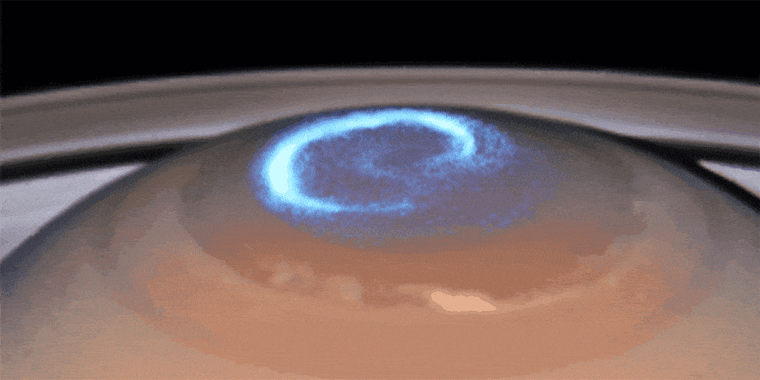With their ethereal glow and swirling tendrils, auroras on Saturn are just as beautiful as even the most dramatic northern and southern lights here on Earth.
Newly released images taken by the Hubble Space Telescope show an intense light show over the ringed planet’s north pole. The composite images of the auroras, taken over a seven-month period in 2017, were also made into a dramatic video.
It’s been known since the 1980s that Saturn has auroras, which occur when streams of charged particles emitted by the sun strike atoms in a planet's atmosphere.
But the new images from Hubble — which has an unparalleled view of the solar system from its orbit more than 350 miles above Earth — afford the best view yet of auroras at the planet’s north pole, said Laurent Lamy, an astrophysicist at the Paris Observatory. Lamy is the lead researcher of a study about the auroras published online July 17 in the journal Geophysical Research Letters.
On Earth, auroras occur when the charged particles in what astronomers call the solar wind strike atmospheric oxygen and nitrogen molecules to produce displays of light at high latitudes. The displays occur regularly on Earth and are visible to the naked eye.

Things are different on Saturn, which has an atmosphere composed mostly of hydrogen. When hydrogen molecules interact with particles in the solar wind, they produce ultraviolet light, which can’t be seen by the naked eye or by ground-based telescopes because Earth’s atmosphere blocks out most UV light.
But Hubble can “see” ultraviolet light, and the scientists’ 2017 observations showed that the stronger the solar wind, the more intense the auroras. In addition, Saturn's auroras were seen to be brightest at dawn and just before midnight.
Saturn's auroras are significantly bigger than those that occur on Earth. The dancing lights seen in the new images cover an area equivalent to almost three times the diameter of our planet, Lamy told NBC News MACH in an email.
Beyond offering a bit of celestial eye candy, auroras can yield key insights about planets. Conor Nixon, a planetary scientist at NASA’s Goddard Space Flight Center in Greenbelt, Maryland, said that by studying auroras “we can learn both about the properties of the gases in the upper atmosphere, as well as [get] a sneak peak into what is happening in the [planet’s] core — both regions which are not normally seen, and hard to investigate remotely.”
Earth and Saturn aren’t the only planets in the solar system with auroras. The light shows have also been spotted on the gas giants Jupiter, Neptune and Uranus, as well as on Mercury.
